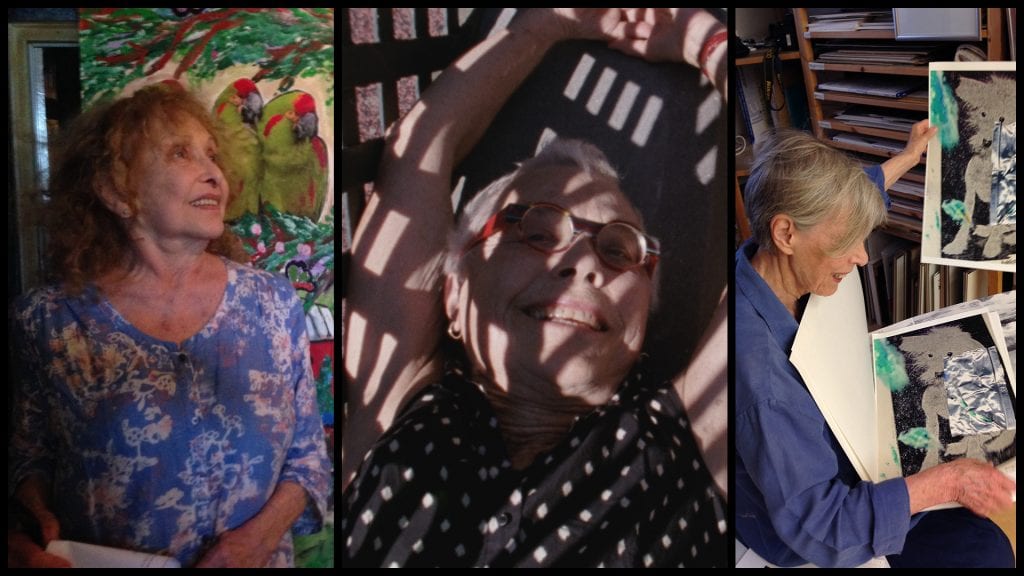Review of Lynne Sachs’ Carolee, Barbara and Gunvor
http://agnesfilms.com/reviews/review-of-lynne-sachs-carolee-barbara-and-gunvor/
April 4, 2018
Written by Julie Casper Roth
Developmentally Edited by Alexandra Hidalgo
Copy Edited and Posted by Jessica Gibbons
Carolee, Barbara and Gunvor (2018). 8:00 minutes. Directed by Lynne Sachs.
It was deep into her artistic practice that Lynne Sachs shifted to a collaborative style of filmmaking. As she recounts on her website, Sachs was in the midst of recording a project when it struck her that those in front of the camera were performing. Aware that such hyperbolic displays might betray the authenticity of her subjects, Sachs invited the subjects to participate with her. No longer was her process about filming and being filmed. Rather, filmmaking became a joint effort that softened the camera as an intermediary and aloof barrier.
It’s this approach to filmmaking that makes Sachs’ most recent work, Carolee, Barbara and Gunvor, such a particularly wonderful piece. The short film doesn’t expose the stories of just any subjects; it looks at the lives of three creative giants who work with the moving image: Carolee Schneemann, Barbara Hammer, and Gunvor Nelson. With filmmakers balancing out both sides of the lens, the collaboration between filmmaker and subject reaches superheroine proportions.
Shot on 8mm and 16mm film, the soft colors and square aspect ratio of the film pull the viewer out of contemporary times. In the first image of the film, a cat is perched on a tree limb. In the next, the cat is acting as sentinel on a porch. The camera looks from the inside of a house out, framing the cat in a doorway. This moment jars me. I hear the voice of Schneemann discussing her entry into the medium of moving images, but the picture quality, the cat, the framing—it all conjures images of Schneemann’s own Fuses. For a moment, I wonder if I’m actually looking at Schneemann’s footage, but the tell-tale painted film frames, frenetic cuts, and abstraction of her work are absent.
Sachs’ camera casually captures mundane moments at Schneemann’s upstate New York home with beautiful, compositional precision. Schneemann describes moments ranging from her first experience with a Bolex camera to her desire to film the ordinariness of light coming through a hospital window. While she describes it, Sachs captures the sentiment; Schneeman is seen talking on the phone, hanging laundry, looking at mail. Sachs also prioritizes otherwise subtle images in and around the home: a dead bird on the porch, light coming through the window, and shots of greenery around the yard. In this piece, collaboration comes in the form of homage and interpretation.
Next, the film moves to the voice and image of Barbara Hammer. Of the film’s three subjects, Hammer is perhaps the most performative of the bunch. In a compositionally stunning scene, Hammer, at turns, walks and jogs the length of an iron fence in New York’s West Village. She repeats this several times, her body mingling with the long shadows cast by the iron slats. Eventually, she addresses the presence of Sachs’ camera. She stops, stares into it—challenges it—until Sachs pulls the camera skyward. A moment later, Hammer is on the ground, bathed in the fence’s shadows and smiling. Accompanying these images is Hammer’s forever youthful voice, explaining her love of performance both with and without her camera.
From here, the viewer moves into Hammer’s studio space to watch her toy with window blinds and choreograph film cameras as she slides them across her table. She discusses identity, and that discussion is punctuated with another challenge to Sachs’ camera; Hammer points the lens of a camera right back at her.
The final section of the triad takes the viewer to a montage of images that focus on the natural: flowers, ducks, a pond, and landscape greenery. There is no audio soundtrack for the first portion of this section: no music and no narration. The faintest sound of birds in the distant background can be missed unless the volume is set to high. Finally, the voice of Gunvor Nelson cuts the silence. It joins the images, describing Nelson’s entry into film and her impending exit from it as well. The images in this section of the film seem crisper, perhaps to reflect the camera Nelson holds in her hands—a digital Nikon. As Nelson and her camera interact with flowers and landscape, Sachs’ camera watches. Eventually, the two artists end up lens to lens, looking down a barrel at one another’s craft.
Carolee, Barbara and Gunvor is an exquisite dance shared by filmmakers and their literal and metaphorical lenses. It’s also a wonderful journey of nostalgia. The look of the 8mm and 16mm film paired with the subject matter easily takes the viewer back to the innovative first moments of women’s experimental filmmaking.


